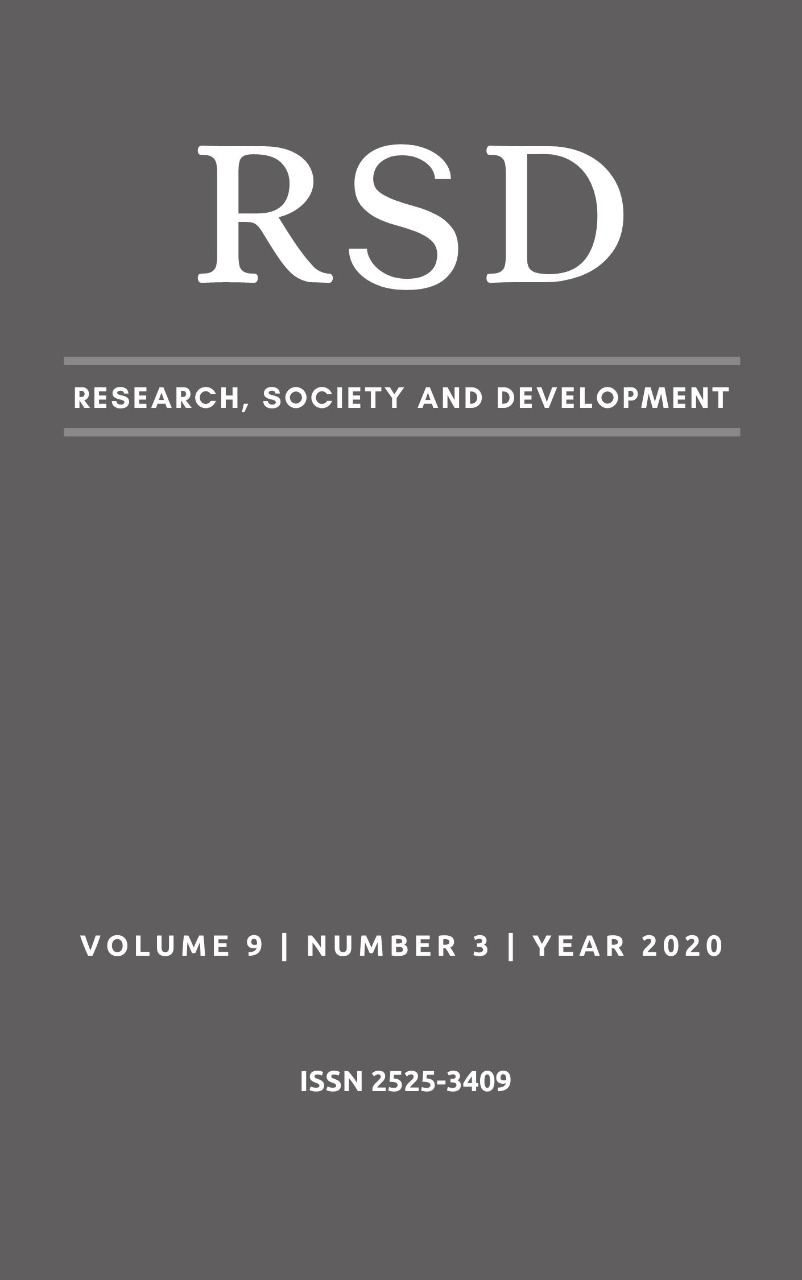Evaluación fitosociológica en la zona de transición cerrado-mate atlántica
DOI:
https://doi.org/10.33448/rsd-v9i3.2350Palabras clave:
Bosque estacional, Fitosociología, Sabana.Resumen
El objetivo del presente trabajo fue caracterizar la vegetación predominante en un área de transición entre los biomas del Cerrado y el Bosque Atlántico. La recolección de datos de campo se realizó para obtener los parámetros utilizados para florística y fitososciología: densidad absoluta (AD), densidad relativa (DR), frecuencia absoluta (AF), frecuencia relativa (RF), dominio absoluto ( DoA), dominancia relativa (DoR), índice de valor de importancia (IVI), índice de valor de cobertura (IVC), índice de Shannon-Weaver (H '). Se muestrearon 274 individuos pertenecientes a 21 familias, distribuidos en 44 especies diferentes. De estos, 44 observamos el predominio de especies que ocurren en los biomas del Cerrado y del Bosque Atlántico que corresponden al 40% del total muestreado, seguidas de especies que ocurren solo en el bioma Cerrado, con el 35% del total de las especies muestreadas. Solo el 15% de las especies encontradas son exclusivamente del bioma del bosque atlántico; y 10% ocurren en el Cerrado, el Bosque Atlántico y también en el bioma del Pantanal. La mayor representatividad está presente en la familia Fabaceae (angicos y aroeira) y Rubiciaea (castillo), que corresponde al 39% de los individuos muestreados, revelando que el área estudiada tiene el mayor número de especies presentes en el cerrado. En cuanto al índice de Shannon-Weaver, presentó baja diversidad florística (1.35 individuos individuales-1). Las tres especies con el índice de valor de mayor importancia fueron el castillo, angico Vermelho y aroeira, todas especies que se encuentran en el bioma del Cerrado, con 43.7; 39.07 y 29.1 respectivamente. La importancia de la mayoría de las especies fue pequeña considerando los valores de densidad, frecuencia y dominancia.Referencias
Andrade, L.A.Z. et al. (2002). Fitossociologia de uma área de cerrado denso na RECOR-IBGE, Brasília – DF. Acta Botânica Brasilica, São Paulo, 16(2): 225 – 240.
Brandon, K., Fonseca, G.A.B., Rylands, A.B. & Silva, J.M.C. (2005). Conservação brasileira: desafios e oportunidades, Belém, PA. Megadiversidade, 1(1).
Farias, C.A., Soares, C.P.B., Souza, A.L. & Leite, H.G. (2002). Comparação de métodos de amostragem para análise estrutural de florestas inequiâneas, Viçosa-MG. Revista Árvore, 26(5): 541-548.
Borges, S. A. L.; Shepherd, G. Flora e estrutura do estrato lenhoso numa comunidade de Cerrado em Santo Antônio do Leverger, MT, Brasil. Revista Brasileira de Botânica, v. 28, n. 1, p. 61 – 74, jan./mar. 2005.
Borges, H. B. N., & Shepherd, G. J. (2005). Flora e estrutura do estrato lenhoso numa comunidade de Cerrado em Santo Antônio do Leverger, MT, Brasil. Brazilian Journal of Botany.
Giácomo, R. G., De Carvalho, D. C., Pereira, M. G., De Souza, A. B., & Gaui, T. D. (2013). Florística e fitossociologia em áreas de campo sujo e cerrado sensu stricto na estação ecológica de Pirapitinga–MG. Ciência Florestal, 23(1), 29-43.
Garcia, H. L. (2002). Um método para condução de inventários florestais sem o uso de equações volumétricas. Revista Árvore, 26(3), 321-328.
Silva, M. B., Kliemann, H. J., da Silveira, P. M., & Lanna, A. C. (2007). Atributos biológicos do solo sob influência da cobertura vegetal e do sistema de manejo. Pesquisa Agropecuária Brasileira, 42(12), 1755-1761.
Silva, J. D. S. V. D., Pott, A., Abdon, M. D. M., Pott, V. J., & Santos, K. R. D. (2011). Projeto GeoMS: cobertura vegetal e uso da terra do Estado de Mato Grosso do Sul. Campinas/SP: Embrapa Informática Agropecuária, 64.
Neto, V. L. S., de Oliveira, A. L., de Souza Ferreira, R. Q., de Souza, P. B., & Viola, M. R. (2016). Fitossociologia e distribuição diamétrica de uma área de Cerrado sensu stricto, Dueré-TO. Revista de Ciências Ambientais, 10(1), 91-106.
Vibrans, A. C., Sevgnani, L., Lingner, D. V., de Gasper, A. L., & Sabbagh, S. (2010). Inventário florístico florestal de Santa Catarina (IFFSC): aspectos metodológicos e operacionais. Pesquisa Florestal Brasileira, 30(64), 291.
Descargas
Publicado
Número
Sección
Licencia
Los autores que publican en esta revista concuerdan con los siguientes términos:
1) Los autores mantienen los derechos de autor y conceden a la revista el derecho de primera publicación, con el trabajo simultáneamente licenciado bajo la Licencia Creative Commons Attribution que permite el compartir el trabajo con reconocimiento de la autoría y publicación inicial en esta revista.
2) Los autores tienen autorización para asumir contratos adicionales por separado, para distribución no exclusiva de la versión del trabajo publicada en esta revista (por ejemplo, publicar en repositorio institucional o como capítulo de libro), con reconocimiento de autoría y publicación inicial en esta revista.
3) Los autores tienen permiso y son estimulados a publicar y distribuir su trabajo en línea (por ejemplo, en repositorios institucionales o en su página personal) a cualquier punto antes o durante el proceso editorial, ya que esto puede generar cambios productivos, así como aumentar el impacto y la cita del trabajo publicado.


